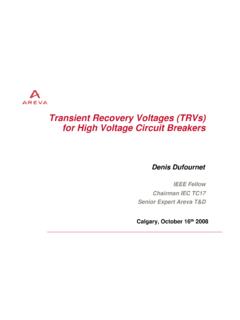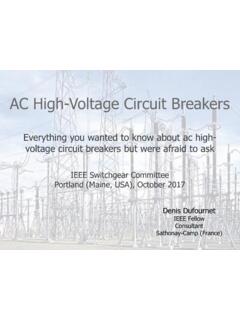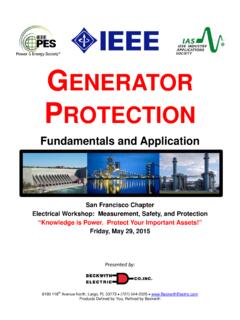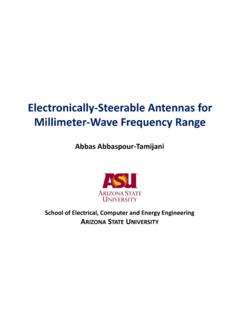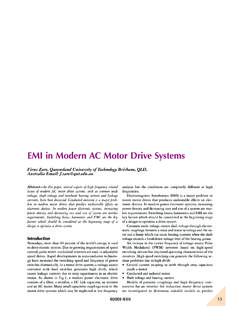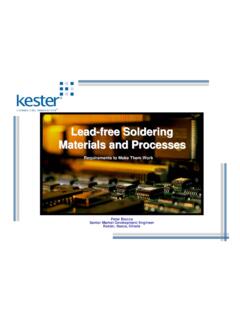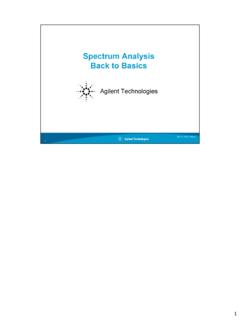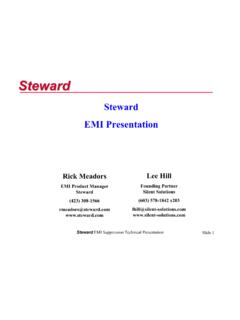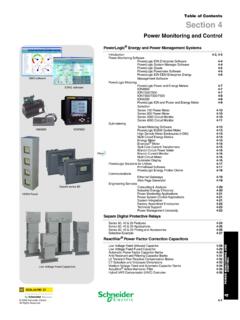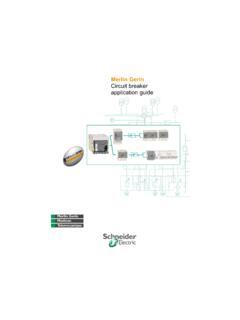Transcription of Transformer Protection - Institute of Electrical and ...
1 5/29/2015 Schweitzer Engineering Laboratories1 Copyright SEL 2015 IEEE SF Power and Energy SocietyMay 29, 2015 Transformer ProtectionAli Kazemi, PERegional Technical MangerSchweitzer Engineering LaboratoriesIrvine, CASources of Transformer Stresses Thermal cycling Vibration Local heating due to magnetic flux Impact due to through-fault current Heating due to overload or inadequate coolingSource: IEEE Std. , IEEE Guide for Protecting Power Transformers5/29/2015 Schweitzer Engineering Laboratories2 Transformer Failure Statistics1983 1988 Winding failures37% Tap changer failures22% Bushing failures11% Terminal board failures3% Core failures1% Miscellaneous failures26%Source: IEEE Std. , IEEE Guide for Protecting Power TransformersTransformer Protection Differential Protection current Transformer Performance Through Fault Protection Mechanical Protection5/29/2015 Schweitzer Engineering Laboratories3 Design Considerations for Transformer Differential Protection CT ratio and CT voltage class selection CT connections current phase shifts across Transformer Inrush detection Differential pickup settings Zero-sequence currents Slope High excitation currentsDesign Considerations for Transformer Backup Protection Overcurrent Directional overcurrent External faults Sudden pressure Hot spots Loss of coolers5/29/2015 Schweitzer Engineering Laboratories4 Differential Protection Overcurrent50 Protected EquipmentIOP= 0 CTCTN ormal LoadBalanced
2 CT RatioDifferential Protection5/29/2015 Schweitzer Engineering Laboratories5 Common Problems With Differential Protection False differential current can occur if CT saturates during through fault Some measure of through current can be used to desensitize relay when high currents are present50 Protected EquipmentIOP 0 CTCTE xternal FaultDifferential current and CT Saturation5/29/2015 Schweitzer Engineering Laboratories6 Possible Solution Percent Slope DifferentialProtected EquipmentIRCTRCTRR elay (87)ISIRPISPC ompares:OPS RSRRTIIIIIk I k 2 Dual-Slope Differential Digital RelayIOPIR1IR2IR3 IRTM inimum Pickup, IPUU nrestrained Pickup, IHSO perating RegionSlope 2 Slope 1 Restraining Region5/29/2015 Schweitzer Engineering Laboratories7 Adaptive Slope for SecuritySlope 1 Internal FaultIRTIOPS lope 2 External FaultRestrainOperate87 PDifferential Protection Summary Overcurrent differential scheme is simple and economical but does not respond well to unequal CT performance Percentage differential scheme responds better to CT saturation Differential principle provides best Protection selectivity and speed5/29/2015 Schweitzer Engineering Laboratories8 current TransformersCurrent Transformer (CT) Principle CT isolates relay from the HV system Drastically reduces currentIdeally.
3 Is= ip/ Ns5/29/2015 Schweitzer Engineering Laboratories9 Core and Secondary Winding ExampleThe current Transformer Equivalent Circuit5/29/2015 Schweitzer Engineering Laboratories10 Induced Secondary Voltage Assuming the CT is not saturated, and magnetic flux density (B) is sinusoidal: Induced secondary voltage is approximately: Note: If Bmax, Ns, and f are fixed, the only way to obtain larger induced voltages is to make A larger. This implies a larger iron 2sssfVN ABf N AB maxmaxsin sin BBt BAABt Excitation Curve for a C400 Multiratio CT5/29/2015 Schweitzer Engineering Laboratories11 Core-Balance current TransformerRelayIsabcShieldIaIbIcINRelay Core-Balance CTWhich Photo Shows Correct Installation?5/29/2015 Schweitzer Engineering Laboratories12CT Burden CalculationIPISVS+ ZLEADSZDEVICECT Terminal Voltage S S B S LEADSDEVICEVIZIZ Z ANSI Standard Terminal Voltage Rating Defines minimum CT terminal voltage for 20 times nominal current Standard burden <10% ratio error Applies to full winding Using CT taps reduces accuracy5/29/2015 Schweitzer Engineering Laboratories13C Class Terminal Voltage RatingVSTD= 20 IS RATEDZB STDFor IS RATED= 5 A secondaryC ClassZB STD ( )VSTD(V)C1001100C2002200C4004400C8008800 Avoiding CT Saturation for Asymmetrical (s)
4 VSR tLSFBV2 IZe cost 5/29/2015 Schweitzer Engineering Laboratories14 Avoiding CT Saturation for Asymmetrical FaultsIF= per-unit fault currentZB= per-unit burdenPredicting CT Saturation in Asymmetrical Faults C400, 2000/5 CT with 1 burden ZB= 1 ZB STD= 4 Maximum asymmetrical fault current for X/R = 12: IFmax= 20 / (12 + 1) = pu = kA5/29/2015 Schweitzer Engineering Laboratories15 IFZB(1 + X/R) = 20 IFZB(1 + X/R) = 505/29/2015 Schweitzer Engineering Laboratories16 Common CT ConnectionsWyeDeltaIaIbIcIaIbIcIasIbsIcs IresIas IcsIcs IbsIbs IasEffective Burden Depends on CT Connections and Fault Types CT ConnectionEffective Burden Impedance (ZB) for Different Types of FaultsThree Phase or Phase to PhasePhase to GroundWyeZLEADS+ ZDEVICE2 ZLEADS+ ZDEVICED elta3 (ZLEADS+ZDEVICE)2(ZLEADS+ ZDEVICE)5/29/2015 Schweitzer Engineering Laboratories17 Select CT That Will Not Saturate Know maximum available symmetrical fault current (use VS VSTDand IFZB 20 to verify no saturation) Determine X/R ratio and worst-case asymmetrical fault (use IFZB(X/R + 1))
5 20 to determine CT will not saturation under asymmetrical fault conditions)Determine Maximum Emergency Rating of Transformer Calculate full load rating (FLA) of Transformer Ensure CTR matches FLA as closely as possible5/29/2015 Schweitzer Engineering Laboratories18 DABY or DY1 Transformer ConnectionYDAC or YD1 Transformer Connection5/29/2015 Schweitzer Engineering Laboratories19 Traditional Compensation ab 21I I N/N bc 21I I N/N ca 21I I N/NaIbIcI211 2N11 NCTR CTR bc2I I /CTR ca2I I /CTR ac2I I /CTR ca 211I I N/N /CTR bc 211I I N/N /CTR ab 211I I N/N /CTRC ompensation With Digital RelaysCurrent Scaling and Phase-Shift Compensation Are Internal Exact current scaling Phase-shift compensation for all Transformer connections Allowed wye-CT connection5/29/2015 Schweitzer Engineering Laboratories20 current Scaling With Digital RelaysDigital relays can fully compensate for current amplitude differencesDigital Relays Allow
6 Connection of CTs in WyeWinding 2 Winding 1X2X3X1abcH3H2H1 ABCICW1 IBW1 IAW1 ICW2 IBW2 IAW25/29/2015 Schweitzer Engineering Laboratories21 current Scaling and Phase-Shift Compensation11 TAP21 TAP11 TAPZero-Sequence current for an External FaultDelta compensation removeszero-sequence current87 Zero SequenceNegative SequencePositive SequenceS1ZT1ZS2ZT2ZT0ZS0Z5/29/2015 Schweitzer Engineering Laboratories22 Zero-Sequence current RemovalTraditional RelaysAuxiliary CTs connected aszero-sequence trap87 Zero-Sequence current RemovalDigital Relay11 TAP21 TAP5/29/2015 Schweitzer Engineering Laboratories23 Differential current Caused by Magnetizing Inrush, Overexcitation, and CT SaturationMagnetizing Inrush current Obtained From Transformer Testing5/29/2015 Schweitzer Engineering Laboratories24 Inrush current Harmonic ContentHarmonic-Based Methods in a Relay With Three Differential Elements Independent harmonic restraint Independent harmonic blocking Common harmonic blocking5/29/2015 Schweitzer Engineering Laboratories25 Harmonic-Based Method ComparisonFeatureIndependent Even-Harmonic RestraintCommon Even-Harmonic BlockingSecurity for external faultsHighHighSecurity for inrushHighHighDependabilityHighHighSpeed for internal faults LowerHigherSpeed for internal faults during energizationHigherLowerSlope characteristicAdaptive(harmonic dependent)Fixed(harmonic independent)
7 Combined Harmonic Blocking and Restraint for Optimal Protection Faults during inrush conditions Faults during normal conditions5/29/2015 Schweitzer Engineering Laboratories26 Harmonic Restraint Mode Operation conditions IOP> IPU IOP> SLP IRT+ K2I2+ K4I4 Blocking condition (K5I5> IOP)Application Considerations5/29/2015 Schweitzer Engineering Laboratories27 selection of Characteristic Settings Minimum pickup: constant differential current Slope 1: proportional differential current Slope 2: CT saturationConstant and Proportional Differential Currents Constant Exciting current (1 to 4% of rated current ) Unmonitored load in Protection zone Proportional Tap mismatch: 0% in digital relays Tap changers: NLTC 5%; LTC 10% Linear CT errors: 3% Relay errors: 5%5/29/2015 Schweitzer Engineering Laboratories28DO NOT DELETEC ombined TransformerBus and Feeder5/29/2015 Schweitzer Engineering Laboratories29 Results of Repeated Faults and Mechanical Stresses Transformer Overcurrent and Mechanical Protection Apply overcurrent Protection for through-fault damage to transformers Review IEEE thermal model Understand how sudden pressure relays provide sensitive Protection for turn-to-turn faults and how to apply them5/29/2015 Schweitzer Engineering Laboratories30 Overcurrent Protection Possible primary Protection for small transformers Backup of primary Protection (87 and 63) Backup Protection for faults in adjacent Protection zones (trip Transformer before it is damaged)
8 Transformer Damage Curves Infrequent fault incident curve (fewer than 5 faults in life of Transformer ) Use infrequent fault curve For faults in zones that are cleared by high-speed Protection For systems without overhead lines5/29/2015 Schweitzer Engineering Laboratories31 Category IVAbove 10,000 KVA single phaseAbove 30,000 KVA three phaseSource: IEEE Std. , IEEE Standard for Standard General Requirements for Liquid-Immersed Distribution, Power, and Regulating TransformersIEEE Standard Guide for Loading Mineral Oil-Immersed transformers Top-oil temperature Hottest-spot temperature Loss of life5/29/2015 Schweitzer Engineering Laboratories32 Transformer Cooling System Contact inputs indicate active cooling system status Thermal model selects constants for three cooling systems Oil-air (OA) Forced-air cooled (FA) Forced oil-air (FOA) Transformer Thermal Monitoring Optimizes Operation Transformer Protection System operation System planning Capital investment5/29/2015 Schweitzer Engineering Laboratories33 Mechanical ProtectionSudden Pressure Relay (ANSI 63) Gas space (sudden pressure)
9 Under oil (fault pressure)Qualitrol Rapid Pressure Rise Relay (Under-Oil Type)5/29/2015 Schweitzer Engineering Laboratories34 Combine Relays for Best Transformer Protection Differential relay is primary Protection for most faults in tank and bus work Sudden pressure relay is primary Protection for turn-to-turn faults and backup 87 for large faults inside tank Overcurrent relays are primary Protection for through-fault damage and provide backup for faults in tank and bus workQuestions?
